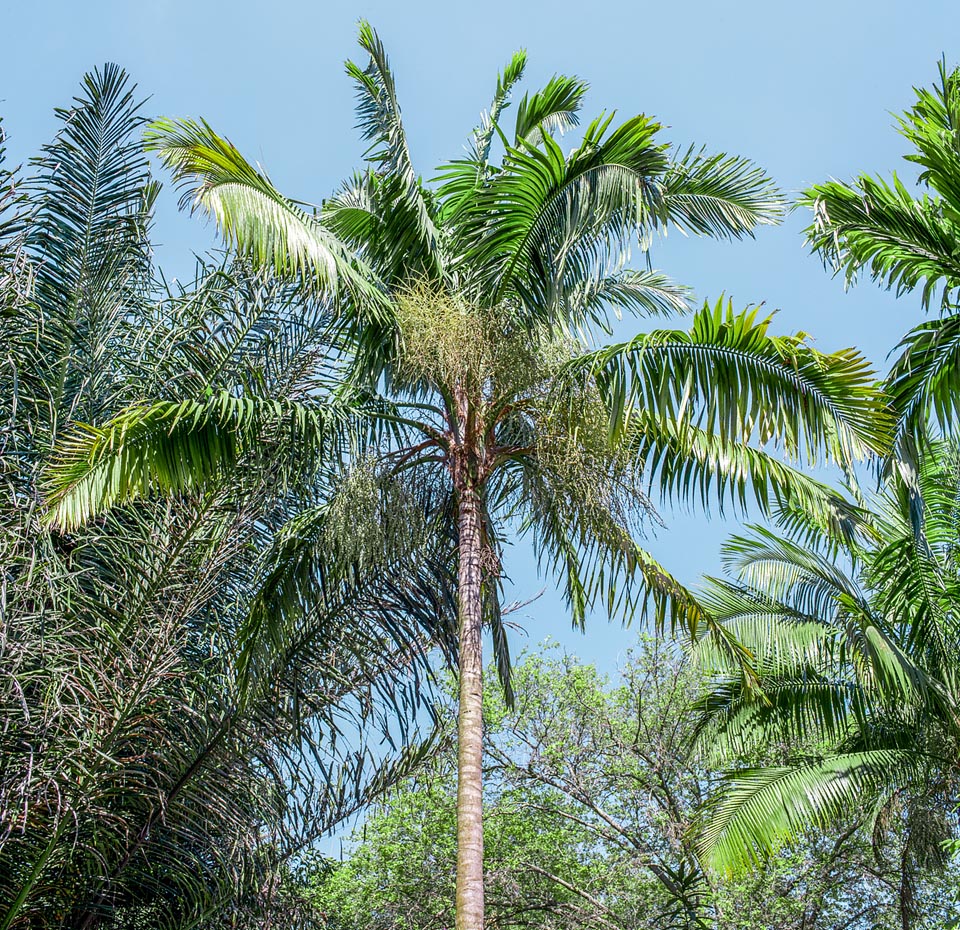Family : Arecaceae

Text © Pietro Puccio

English translation by Mario Beltramini
The variety is native to Palau, in the Caroline Islands, where it dominates the forests on the rocky slopes of volcanic origin.
The name of the genus is the combination of the Greeks adjective “ἕτερος” = different and of the substantive “σπάθη” = sword, with reference to the bracts (spathes) of different length that enclose the inflorescence. The name of the species is the Latin adjective “elatus, a, um” = high, noble; that of the variety refers to the origin site, Palau.
Common names: akaboek, asbo, beokl, ebouch, demailéi, domailei (Palau).
The Heterospathe elata var. palauensis (Becc.) Becc. (1934) is an unarmed monoecious palm with solitary stem, erect, cylindrical with rather enlarged base, up to about 15 m tall with a diameter of 20-25 cm, of greyish colour and marked by the annular traces of the junction of the fallen leaves. The leaves, on an about 60 cm long petiole, are pinnate, elegantly arcuate, up to about 3 m long, with the terminal part turned in almost vertical position, with about 70 couples of linear lanceolate leaflets with acuminate apex and prominent central vein, close each other, slightly drooping and regularly arranged along the rachis on a same level, of dark green colour, 60-80 cm long in the central part and 3-3,5 cm broad; the new leaves are initially of dark pink to reddish brown colour. The foliar base, open on the side opposite to the petiole, is about 60 cm long. The inflorescences generate between the leaves (interfoliar), curved, about 1,5 m long, initially enclosed by two deciduous bracts, the outer one being shorter than the inner one, with ramifications of the third order, the primary ones about 80 cm long with numerous thin floriferous rachillae, about 20 cm long, bearing unisexual sessile flowers arranged in triads (a female one between two male) of white colour.

The Heterospathe elata var. palauensis is native to Palau, in the Carolines Archipelago, where dominates the forests on the rocky slopes of volcanic origin. Monoecious, unarmed, with solitary stem, reached the 15 m of height. The seeds are at times utilized in lieu of the betel and the vegetative apex is consumed as “heart of palm” © Giuseppe Mazza
Globose fruits about 0,8 cm long and of 0,6 cm of diameter, of white colour varying from white to red when ripe, containing only one globose 0,6 cm long seed and of 0,5 cm of diameter.
It reproduces by seed in draining loam maintained humid at the temperature of 26-28 °C, with germination times starting from 3-4 months.
Palm having a particularly elegant posture with relatively fast growth, almost unknown out from its origin place, contrary to the species that is perhaps the most known and cultivated of the genus, present almost exclusively in botanical gardens of the tropical and humid subtropical climate regions. It bears the full sun, excepting the first years of growth when it requires a partial shading, and is not particular about the soil provided draining, slightly acidic to alkaline, maintained almost constantly humid, hence requires regular waterings during the dry season in the seasonal climates.
The leaves are employed to fabricate fishing nets and other handicrafts, at times the seeds are utilized in lieu of betel, please see Areca catehu, and the vegetative apex (“palm heart”) is locally consumed, use that causes the death of the plant and then should be consequently forbidden.
Synonyms: Heterospathe palauensis Becc. (1914).
→ For general notions about ARECACEAE please click here.
